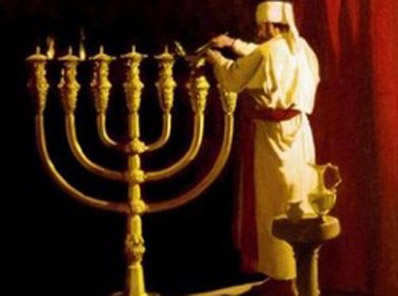by Joy Scott, Am Haskalah Congregant
In Torah Parsha, TERUMAH, we read last week how the magnificent ‘MISHKAN’ (Sanctuary), a sacred place, dedicated to God, was constructed. Parshat TETZAVEH begins with instructions to Moses for creation of the final piece, to be placed in the ‘Tent of Meeting’, outside the dividing curtain. “You shall command the children of Israel to bring you pure olive oil, crushed for lighting, to kindle the lamps, continually; It shall be set up before the Lord from evening to morning; and, be an everlasting statute for future generations from the children of Israel” (1). The fourteenth century Jewish poet and philosopher, Jediaiah ben Abraham Bedersi offered a symbolic expression of this holy commandment in a poem:
“The Torah and humanity comprise the Lamp of God on earth. The Torah is the flame issuing forth from the spark of God in heaven. Humanity, made up of both body and soul, is the torch that draws flame from it. The body is the woven wick and the soul is the purified olive oil; through the intertwining and fusion of torch and flame, the whole House becomes filled with light” (2).
Subsequent to God’s instructions to maintain perpetual light within the Sanctuary, the narrative abruptly shifts to a completely unrelated topic, which essentially extends to the end of this week’s Parsha. Suddenly, Moses is told that his older brother, Aaron, will serve the nation as High Priest (Kohen); and, Aaron’s sons will be anointed as the Priestly class (Kohanim). In biblical times, it was commonplace for Kings, and Rulers of nations to wear resplendent attire, as a symbol of their wealth and authority. Aaron and his sons were selected to their respective positions for a highly unique and singular purpose: serving as liaisons between the Israelites and God .Nevertheless, it was deemed appropriate that they dress in a similar fashion.
To ensure that Aaron was clothed in a strictly specific manner, God said to Moses: “You shall speak to all the wise men, in whom I have filled with the spirit of wisdom, and they shall make Aaron’s garments to sanctify him, so that he can serve Me as a Kohen” (3). Sacred vestments were made for both the ‘dignity and honor’ of Aaron and his sons.
The items of adornment, which were distinctive to the Kohanim included a headband of pure gold with the inscription: ‘Holy To The Eternal’; six stones on each arm, bearing the names of the twelve tribes of Israel; and, a breastplate on the chest, to: “remind each that his Holiness was drawn from God, and from the people, who he was ordained to serve” (4).
God said to Moses: “Tell the children of Israel to be a student of Aaron: loving and pursuing peace; and drawing them near to the Torah” (7).
We need not be Priests to examine ourselves and the way we represent our communities. Like Aaron, if we are inclusive, we exemplify a pursuit of peace; demonstrate a love of others; and, help draw more people to the teachings of the Torah. If we neglect to include anyone, we invalidate our sacred purpose.
FOOTNOTES:
(1) EXODUS (27:20-21)
(2) “An investigation of the World”
(3) Exodus (28:3)
(4) The Torah A Modern Commentary
(5) PIRKEI AVOT (1:12)
